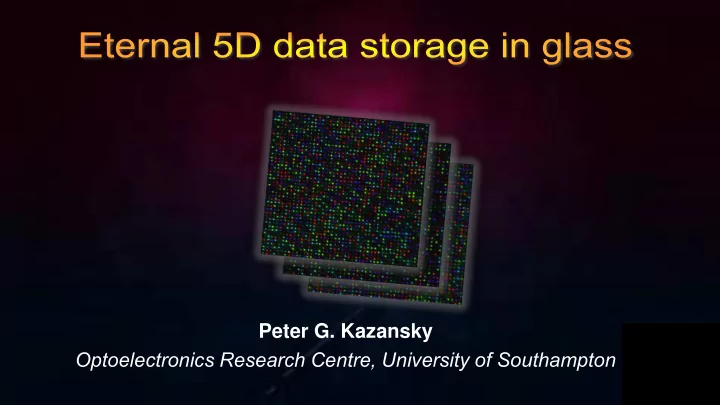

Peter G. Kazansky Optoelectronics Research Centre, University of Southampton
It is estimated that at least million terabytes of data are generated every day. Brain’s memory capacity is in the thousand terabytes range, as much as entire Web.. The size of text collections in Library of Congress is ten terabytes. Terabyte = 10 12 Bytes
Long-term data preservation Nature’s choice: DNA (1M years @ -18 o C) Current archiving technology: Magnetic tape (20 years) Optical based technologies: CD or DVD (10 years) M-Disc (1000 years) Quartz glass (100M years )
Optical data storage benefits Courtesy: Optical Media Roadmap “The revival of Optical Storage” Ken Wood Hitachi Data Systems
Femtosecond laser direct writing: The principle Tight focusing of laser beam (e.g. l =800 nm, Dt = 100 fs) into transparent material High intensity leading to NA > 0.4 multi-photon absorption Structural changes in matter confined to focal volume due to short pulse duration – 3D Intensity ~ 5x10 13 W/cm 2 Electron temperature ~ 10 5 K /10 eV Pressure ~ 10 6 bar
3D optical storage by femtosecond laser writing Conventional optical storage Femtosecond (100 x 10 -15 s) laser Picosecond (10 x10 -12 s) laser induces voids with external stress induced small voids in quartz glass z x Glezer et al. ,Optics Letters (1996)
Femtosecond lasers perform vision-correction surgery
Ultrafast-laser nanostructured (ULN) quartz glass: The finest bulk ripple ever produced by light 20 nm 20 nm E P.G. Kazansky et al., Phys. Rev. Lett., 82 , 2199 (1999) Y. Shimotsuma et al., Phys. Rev. Lett. 91, 247405 (2003)
Ripples on Earth and in space 20 nm 20 nm
Self-organized form birefringence Femtosecond laser nanostructured quartz glass: n e – n o = –5 x10 -3 E Fast x y optical n 0 n 1 axis Quartz crystal: n e – n o = 9 x10 -3
20 nm 20 nm E
4 th and 5 th dimensions: Retardance and slow axis angle Nanogratings produce birefringence characterized by two parameters: (4 th D) Retardance R = | n x’ -n y’ | × d (5 th D) Slow axis angle θ n y n y' 20 nm 20 nm n x' θ E n x
How it works? Position: 3 spatial dimensions Retardance = f( Intensity, Number of pulses ) Slow axis = f( Polarization ) 1 Byte (8 bits) per spot : 32 states (5 bits) of slow axis orientation 8 states (3 bits) of retardance
Comparison CD DVD Blue-ray 5D Capacity 0.7 GB 4.7 GB 23.5GB 360TB per disc Longevity 5 years 7 years 7 years 10^ 20 years Speed 1.2 Mbit/ s 10.5 Mbit/ s 36 Mbit/ s 20 Mbit/ s (1x) (1x) (1x) Current writing speed: 12 Kbits/s Current capacity: 100 GB/disc 5 bits per dot Advantages of 5D in quartz glass: High capacity Long life time
Thermal stability Energy 2.1 µJ Birefringence Energy 1.6 µJ Temperature ( o C) Bricchi and Kazansky, Appl. Phys. Lett. (2006)
Thermal stability T = 900 ° -> τ = 121 h T = 1000 ° -> τ = 32 h æ ö t = k = A exp - E a 1 ç ÷ è ø k b T T = 1100 ° -> τ = 9 h Using the Arrhenius law, T = 30 ° -> τ = 300x10 18 years the lifetime can be extrapolated to the room temperature
Two images in one layer of slow axis
Data writing Retardance Slow axis orientation
Readout 20 m m 130 m m
Data retrieved The idea of the optical memory based on femtosecond laser writing in the bulk of transparent material was first proposed in 1996 [1]. More recently ultrafast laser writing of self-assembled nanogratings in class s a 3 proposed for the polarization m 5 ltiplex E d optical memory, where 42 bits errors the information encoding would be realized by means of two birefringenc m parameters, i.e. the sl g w axis orientation (4th out of 11664 bits dimension) and s 42 ength of retardance (5th dimension), )f addition to (1458 bytes): three spatial coordinates [2, ³ ]. The slow axi { orientation á nd the retardance can be controlled by polarization and intensity of Error rate 0.36% the ` inciden ô beam respectively [4]. The unprecedented parameters including 360 TB/disc data capacity, thermal stabilit 5 p to 1000 ° C and practically unlimited lifetime [5]. However the implementation of digi 4 al d !4 a storage, whi b h is a cruc a al step t k wards the real world applications, has not " een demonst 2 ated by ultraf ! st laser s riting. Here we success n ully recorded and ` retriev g d a ` di o i u al copy • f the text æ ile in 5D using polarization controlled se m f-assembled ` ultrafa ó t laser nano {p ructuring in silica glass.
Magna Carta coded in 5D Courtesy: Ausra Cerkauskaite and Rokas Drevinskas
The eternal copy of UDHR presented to UNESCO at the Year of Light closing ceremony in Mexico
Asteroid of 10 km in diameter collided with Earth 65 million years ago causing mass extinction Ultrafast-laser nanostructured Shocked quartz at (ULN) fused quartz impact site Chicxulub Coincidently, the lamella structures of ULN fused quartz and shocked quartz are similar
Southampton time capsule in quartz glass
Geometrical phase hologram in glass
Conclusions Optical data storage with practically unlimited lifetime in ultrafast laser nanostructured quartz glass is demonstrated. For the first time, storage technology might allow human knowledge to outlive us.
It has been hailed as a particular significant invention as no other storage medium can so safely ensure that data will be accessible by future generations.
Recommend
More recommend